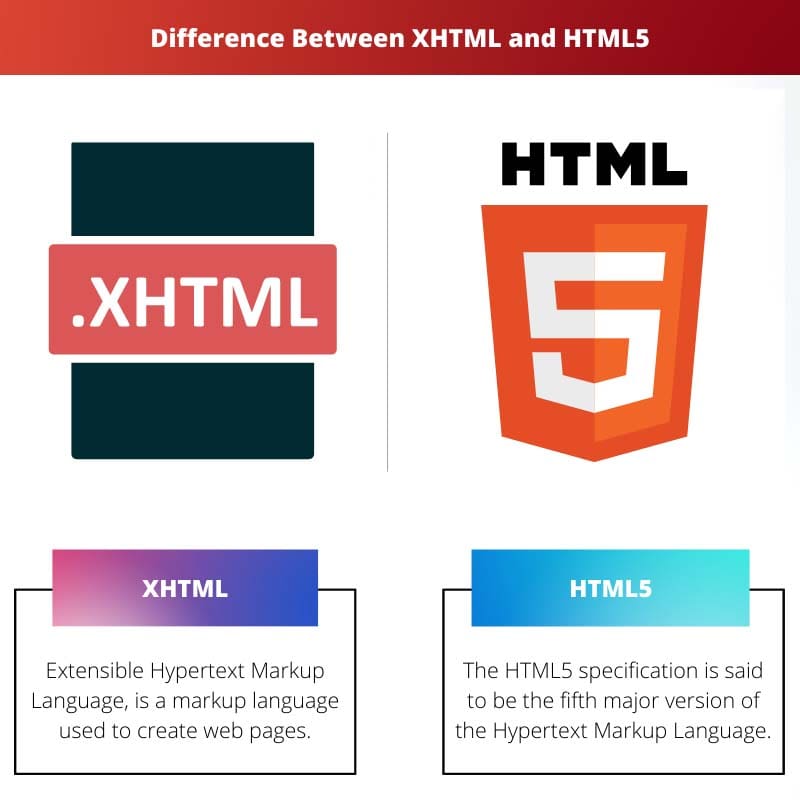XHTML is the full form of Extensible Hypertext Markup Language, which is a version of HTML that was created to work with XML.
HTML5 is the upgraded edition of HTML, markup used for structuring, creating content on the World Wide Web, Web Standards Project developed both HTML and XHTML languages.
Key Takeaways
- XHTML is a strict version of HTML that follows XML syntax rules, while HTML5 is the latest version with new features and APIs.
- HTML5 supports multimedia elements, such as audio and video, without additional plugins.
- XHTML requires strict adherence to syntax rules, whereas HTML5 has more lenient parsing rules.
XHTML VS HTML5
The difference between XHTML and HTML5 is that HTML5 starts with DOCTYPE! because it is new enough to be considered to be HTML by most browsers, and this markup language HTML5 sticks to web documents only. While XHTML doesn’t require more declaration and it places more importance on syntax type

Extensible HyperText Markup Language (XHTML) is used in conjunction with HTML to create web documents.
XHTML application is used to provide structure and meaning to content, as well as other information such as script code, style sheets, images and, videos.XHTML has become the most hyped HTML version after HTML 4.
Hypertext Markup Language 5 is used to mark up web pages. It is capable of displaying graphics and video that can reside on local or remote servers.
HTML5 is a markup language used for structural and semantic markup and as an upgraded version it’s more capable than version HTML 4.
Comparison Table
| Parameters of Comparison | XHTML | HTML5 |
|---|---|---|
| Stands For | Extensible HyperText Markup Language | Extensible HyperText Markup Language |
| Developed By | World Wide Web Consortium (W3C) | World Wide Web Consortium (W3C) and the Web Hypertext Application Technology Working Group (WHATWG) |
| Validation Rules | Follow strict validation Rules. | Do not follow strict validation Rules. |
| Case Sensitive | It is more case sensitive | It is not case sensitive |
| Compatible Use | It does not work on Internet Explorer 8 | Used and supported in all browsers like Firefox, Chrome, Internet Explorer, etc. |
What is XHTML?
Extensible Hypertext Markup Language, is a markup language used to create web pages.
XHTML files contain code that tells a browser how to structure the page and what elements are part of the content, rather than presentational information such as colors and fonts.
XHTML is a reframed from HTML 4.01, which has been in widespread use since 1999.
Originally released by the W3C in 2000, XHTML 1.0 was later replaced by XHTML 1.1 and then XHTML 1.2 each successive version was an incremental improvement upon the previous one.
The most recent version of XHTML is XHTML5, which is still under development but already supported by many browsers.
XHTML documents must be served with an Internet media type of application. This is done with a MIME type configuration. XHTML 1.0 requires support for UTF-8 encoding.
Many websites today use XHTML as the primary markup language because it simplifies website development, facilitates search engine optimization, and improves accessibility for disabled users.
It provides an alternative syntax to HTML 4 and earlier versions, which helps make content portable between different computing platforms and language
It also provides several facilities that support Web development without using the presentational features of HTML 4 earlier versions.

What is HTML5?
The HTML5 specification is said to be the fifth major version of the Hypertext Markup Language (HTML), the current standard markup language for creating web pages and web applications.
It helps to create websites and web applications. HTML5 provides new features to make web pages more interactive, powerful, and easier to access.
It Uses new elements to define the different parts of our page (header, footer, article).
It Uses new form elements (email, search) and uses microdata attributes to describe the objects on our page with RDFa Lite syntax.
Most of it also gathers data from users through new types of controls (date picker, range slider).
There is no need for third-party plug-ins required to Include video and audio natively on our site (for older browsers). It was released in 2014 and it is still a work in progress.
Despite some limitations, developers are already using it to design games, interactive websites, and even mobile apps.
HTML 5 is intended to subsume not only HTML 4 and XHTML 1, but also XUL, SVG, and MathML.
It includes new features that include New tags and attributes, Canvas API, Video support Geolocation API, Forms API, Web Storage API, Drag and drop support.

Main Differences Between XHTML and HTML5
- Most webpages Platforms use HTML (such as blogger) but some websites are using XHTML(such as WordPress) where tags are included in XML tags too.
- XHTML is not a subset of HTML5, it’s an alternative to HTML4 and XHTML1.HTML5 doesn’t have strict requirements whereas XHTML have more requirements.
- In XHTML Header tags footer tags, section tags, article tags, nav, and divs with classes are not used but in HTML 5 these tags are specifically used.
- In HTML5 Closing tag can be discluded and no tag restrictions, but in XHTML tag have restrictions and the Closing tag cannot be omitted.
- XHTML is suitable for desktop computers while HTML5 is suitable for both mobile and desktop devices.




